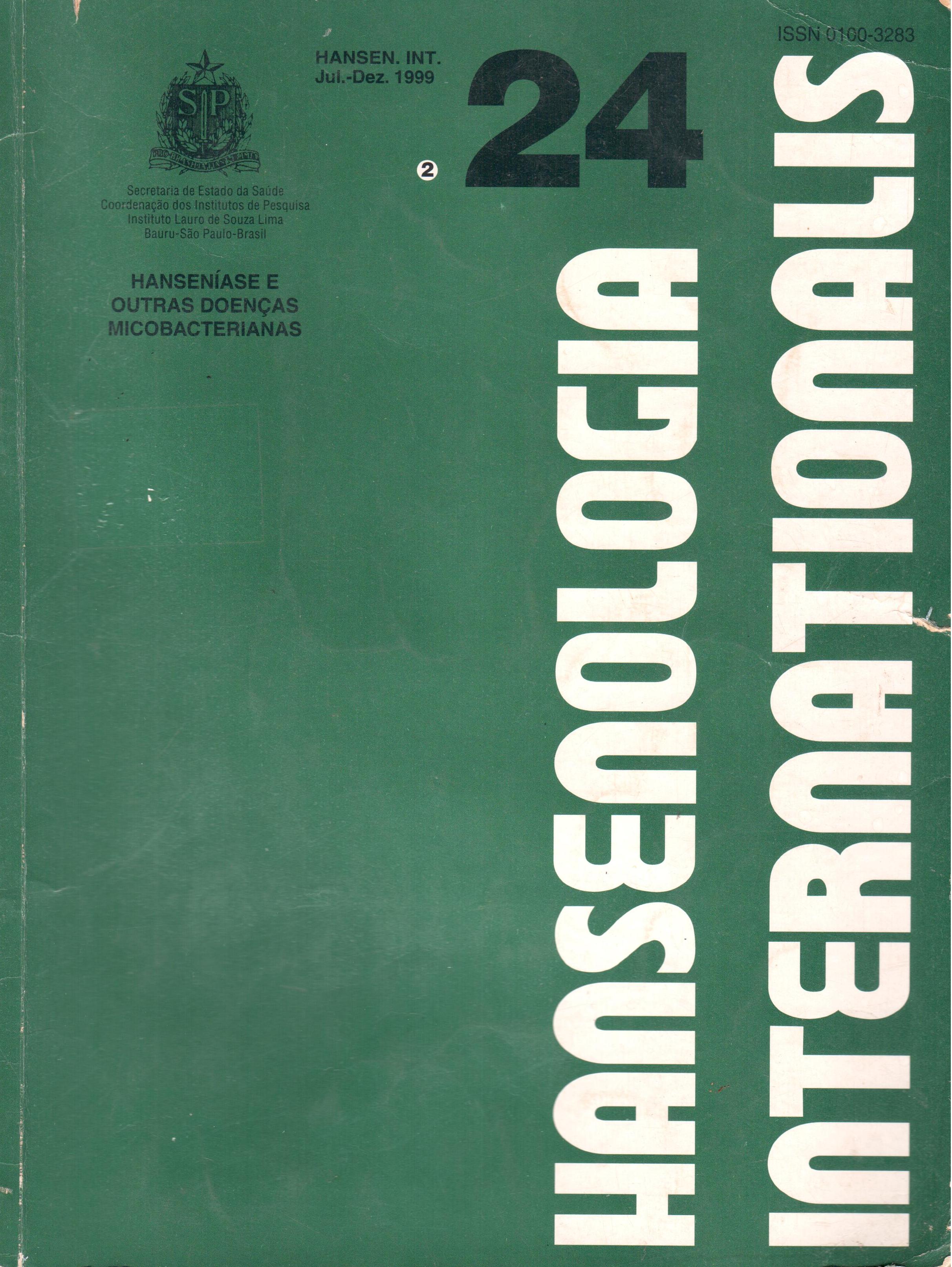Resumo
Considerando as vias aereas superiores como a mais provavel porta de entrada do M. teprae no organismo, no presente estudo avaliou-se 0 comportamento do bacilo inoculado experimentalmente via intranasal. Assim, camundongos Suiços foram inoculados por instilação nasal com M. teprae e sacrificados em diferentes periodos de tempo. Em cada sacrificio os pulmoes foram removidos e submetidos ao lavado broncoalveolar (LBA) e analise histopatológica. 0 LBA foi avaliado quanto ao numero de bacilos recuperados e numero total e diferencial de celulas inflamatórias; foi ainda semeado em meios de cultivo Lowenstein-Jensen e Middlebrook 7H9 e 7Hll. No LBA foram encontrados bacilos ate 0 6Q mes de inoculação; nao houve crescimento de micobacterias nas culturas. 0 numero total de celulas, linfócitos e neutrófilos do LBA obtido de camundongos infectados foi maior que o do grupo controle ate 0 6Q mes da experimentação. Aanalise histopatológica revelou pequenos infiltrados celulares distribuidos pelo parenquima pulmonar e ao redor de vasos ate 0 62 mes de sacrificio; nao foram observadas lesoes de disseminação. Os resultados obtidos revelam que a inoculação de M. leprae, via intranasal, em camundongos Suiços, nao levou ao desenvolvimento da doença nem a multiplicação dos bacilos; assim estudos adicionais envolvendo outras linhagens de camundongos poderao ser uteis para determinar a importancia da via intranasal na infecção hansenica.
Referências
2. BILYK,N. et al. Funtional studies on macrophage populations in the airways and the lung wall of sPF mice in the steadystate and during respiratory virus infection. Immunology, v.65, pA17-425, 1988.
3. BRAND, P.w. Temperature variation and leprosy deformity. Int. }. Leprosy, v.27, p.1-7, 1959.
4. CHEHL, S. et al. Transmission of leprosy in nude mice. Amer. }. Trop. Med. Hyg. , v.34, p. 1161-1166, 1985.
5. DAVEY, T.F., REEs, R.J.W. T he nasal discharge in leprosy: clinical and bacteriological aspects. Leprosy Rev. , vA5, p.121-134, 1974.
6. FARACO, J. Bacilos de Hansen e cortes de parafina: Metodo complementar para pesquisa de bacilos de Hansen em cortes de material incluido em parafina. Rev. bras. Leprol., v.6, p.177-180, 1938.
7. FIT E, G.L. Staining of acid-fast bacilli in parafin sections. Am. }. Pathol. , v.14, pA91-507, 1938.
8. FREUDENBERG, N. et al. Function and "homing"of the lung macrophages. I. Evidence of functional heterogeneity of mobile cells of the murine lung parenchyma in the bronchoalveolar lavage (BAL). Virchows Arch. B Cell Pathol. v,64, p.191-197, 1993.
9. HALEY, P.J. et a/. Comparative morphology and morphometry of alveolar macrophages from six species. Am. }. Anat. , v.191, pAOl-407, 1991.
10. HASTINGS, R. C Leprosy. 2. ed. Edinburgh: Churchill Livingstone, 1994. 470p.
11. HUBsCHER, S. et al. Discharge of Myco-bacterium leprae from the mouth in lepromatous leprosy patients. Leprosy Rev. , v.50, pA5-50, 1979.
12. KIMPEN, J.L.L., OGRA, P.L. T cell redistribution kinetics after secondary infection of BALB/c mice with respiratory syncytial virus. Clin. Exp. Immunol., v.91, p.78-82, 1993.
13. LEVITZ, S.M., DIBENEDET TO, D.J. Paradoxical role of capsule in murine bronchoalveolar macrophage-mediated killing of Cryptococcus neoformans. }. Immunol. , v.142, p.659-65, 1989.
14. McDERMOTT-LANCASTER, R.D., McDOU-GALL, A.C Mode of transmission and histology of M. leprae infection in nude mice. Int. }. Exp. Path. , v.71, p.689-700, 1990.
15. OPENSHAW, P.J.M. Flow cytometric analysis of pulmonary lymphocytes from mice infected with respiratory syncytial virus. Clin. Exp. Immunol. , v.75, p.324-8, 1989.
16. PALLEN, M.J., McDERMOT T, R.D. How might Mycobacterium leprae enter the body? Leprosy Rev. , v.57, p.289-297,1986.
17. REEs, R.J.W., McDOUGALL, A.C Airbone infection with Micobacterium leprae in mice. Int. }. Leprosy, vA4, p.63-68, 1976 .
18. RIDLEY, D.s., HILSON, G.R.F. A logarithimic index of bacilli in biopsies. I. Method. Int. }. Leprosy, v.35, p.184-186, 1967.
19. SAWY ER, R.T. Experimental pulmonary candi-diasis. Mycopathologia, v.l 09, p. 99-109, 1990.
20. SHEPARD, CC T he experimental disease that follows the infection of human leprosy bacilli into foot pads of mice.}. Exp. Med. , v.112, pA45-454,1960.
21. SUGAR, A.M., PICARD, M. Macrophage and oxidantmediated inhibition of the ablity of live Blastomyces dermatitidis conidia to transform to the pathogenic yeast phase; implications for the pathogenesis of dimorphic fungal infections. J. Infect. Dis. , v.163, p.371-5, 1991.
22. TAKIZAWA, H. et al. Experimental hyper-sensitivity pneumonitis in the mouse: histologic and immunologic features and their modulation with cycloporin A. }. Allergy Clin. Immunol. , v.81, p.391-400, 1988.
23. VAUX-PERETZ, F., MEIGNIER, B. Comparison of lung histopathology and bronchoalveolar lavage cytology in mice and cotton rats infected with respiratory syncytial vitus. Vaccine, v.8, p.543-8-1990.
24. VAUX-PERETZ, F. et a/. Comparison of the ability of formalininactivated respiratory syncytial virus, immunopurified F, G and N proteins and cell lysate to enhance pulmonary changes in BALB/c mice. Vaccine, v.l 0, p.113-118, 1992.
25. VILANI-MORENO, F.R. et al. Study of pulmonary experimental paracoccidioidomycosis by analysis of bronchoalveolar lavage cells: resistant vs. susceptible mice. Mycopathologia, v.141, p.79-91, 1998.
26. WHO - World Health Organization- Laboratory Techniques for Leprosy (WHO/Css/LEP/86A), 1987, p.l07-118.

Este trabalho está licenciado sob uma licença Creative Commons Attribution 4.0 International License.
